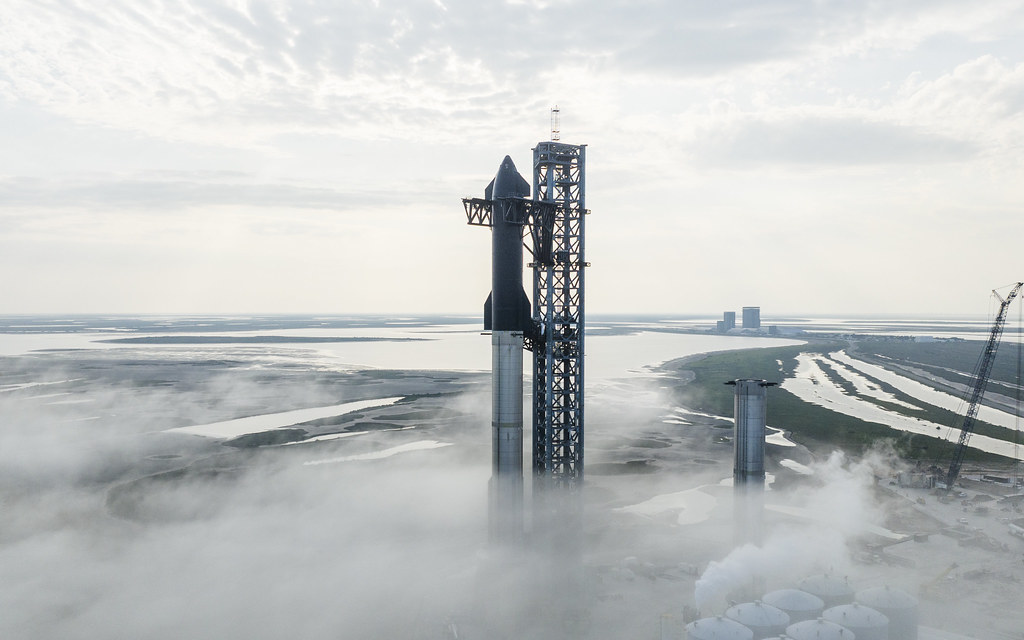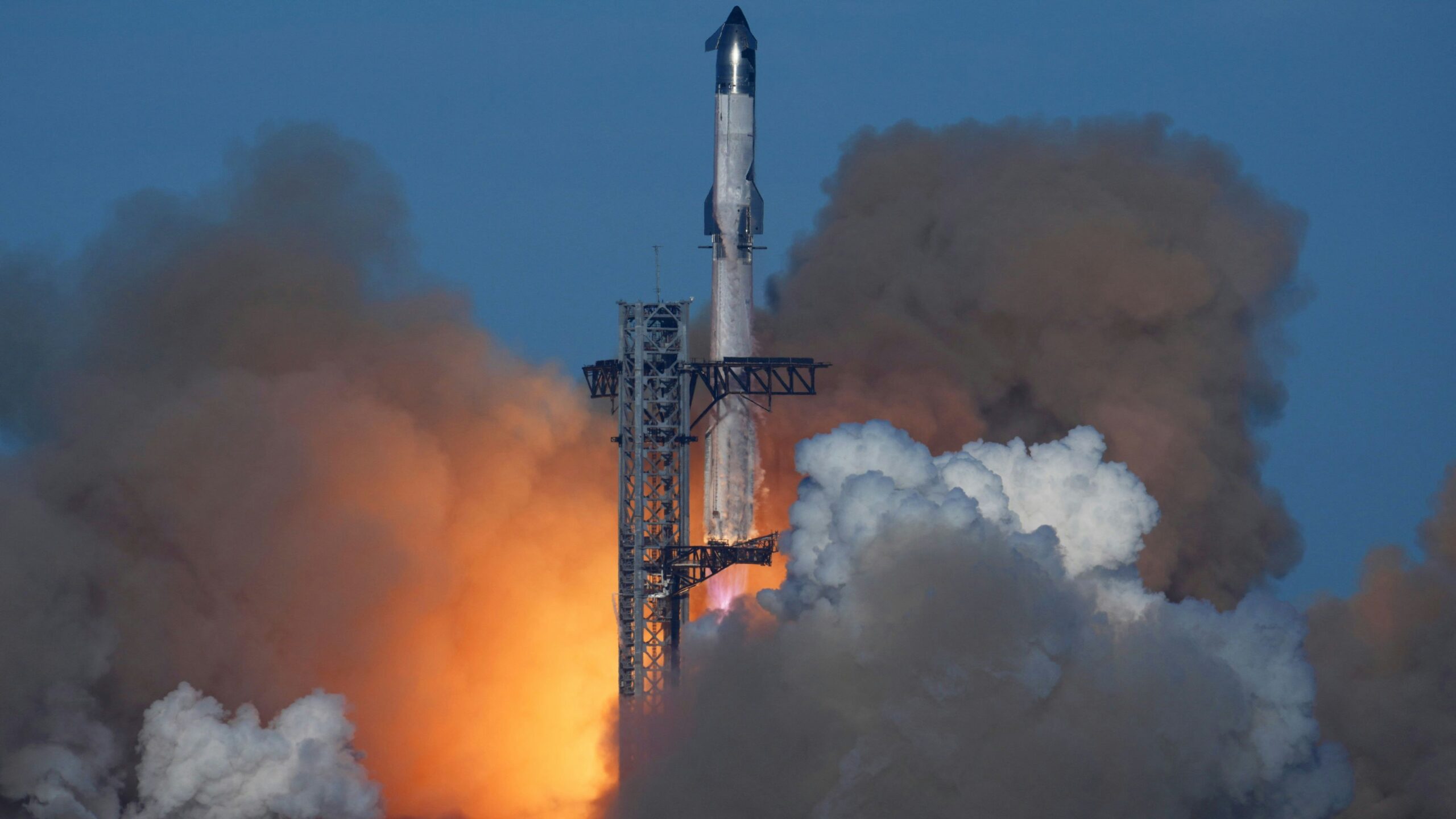SpaceX is pushing the boundaries of space exploration once again, with the B14 booster officially selected for the next Starship flight. As testing nears, exciting developments are emerging regarding booster upgrades, reusability milestones, and cutting-edge engine configurations.
In addition to the Starship Flight 9 preparations, we will also take a deep dive into the recently launched Fram 2 mission, a groundbreaking SpaceX mission that is making history in polar orbit exploration.
Let’s break down what’s happening with SpaceX’s biggest projects, how B14 and Fram 2 are shaping the future, and what to expect in the coming weeks.
B14 Booster Officially Selected for Flight 9
After months of speculation, SpaceX has confirmed that B14 will be the booster for Starship Flight 9. This decision is particularly significant because it marks another step toward full reusability, one of the core goals of the Starship program.
One of the biggest questions leading up to this decision was whether B14 or B16 would be used. With B14 now officially selected, the booster has already been moved to the orbital launch mount (OLM) for final pre-flight preparations.
Key Milestones in B14’s Preparation
- March 31 – April 1: B14 was transported, lifted, and secured onto the orbital launch mount.
- April 3 – 4: Planned static fire tests, with different engine configurations and fuel levels.
- Post Testing: The booster will return for final inspections and installations before integration with the Starship upper stage (S35).
Once testing is complete, the final launch preparations will commence, and we could see Flight 9 taking off as early as April 20.

Starship S35 Upper Stage Testing
While the B14 booster is undergoing rigorous checks, the Starship S35 upper stage is also moving through engine installations and static fire testing.
What’s Happening with S35?
- Engine installation is currently happening inside Mega Bay 2.
- After completion, it will move to Massie for static fire tests.
- S35 is expected to undergo multiple static fire tests, similar to the booster, to validate new upgrades and ensure peak performance.
With both B14 and S35 progressing well, Flight 9’s April launch window remains highly possible.
What’s New with the B14 Booster?
SpaceX’s commitment to booster reusability is evident in the B14 upgrades and engine refinements spotted during recent preparations.
Upgraded Raptor Engines
One of the most interesting revelations is the engine modifications on B14. New Raptor engines have been installed, with some showing a darker finish and a white symbol—indicating possible new protective coatings.
- Many of the outer ring engines have been replaced with upgraded versions.
- Raptor Pi (Raptor 314) could potentially fly for a third time, marking a historic step in reusability.
- Heat exposure signs on the middle and inner ring engines suggest some have been reused from previous missions.
Key Questions About the B14’s Final Flight
Despite these innovations, B14 will not be recovered after Flight 9. Instead, SpaceX plans to intentionally land the booster in the ocean—potentially to focus on ship performance improvements.
While this is a bit disappointing, this mission still represents a major leap forward for Starship’s reusability.
Fram 2 Mission: A New Era in Human Spaceflight
While SpaceX is preparing for Flight 9, another revolutionary mission has already made history—Fram 2.
Launched on March 31 at 9:46 AM ET, Fram 2 is the first human spaceflight to explore Earth’s polar regions.
Mission Highlights
- The Dragon spacecraft separated from Falcon 9’s second stage about 10 minutes after liftoff.
- Crew onboard consists of four astronauts, referred to as “Fronauts.”
- The mission follows a 90-degree polar orbit—a unique trajectory never used before in a crewed mission.
Why is Fram 2 Important?
- First-Ever Human Polar Orbit Exploration
- This marks the first time astronauts have traveled in orbit over the poles, offering a new perspective on Earth’s polar regions.
- Stunning footage and images of Earth’s icy landscapes have been captured directly from Dragon’s cupola.
- Starlink Laser Communication Testing
- Fram 2 is testing laser-based Starlink connectivity in orbit.
- This follows a similar test from Polaris Dawn, but Fram 2 operates at a lower altitude (440 km).
- Scientific Breakthroughs
- The crew is conducting 22 scientific experiments to advance space research.
- First-ever X-rays of the human body in orbit will be conducted to study bone and muscle loss in microgravity.
- Growing mushrooms in space—a test to explore space farming for future Mars missions.
What’s Next for Fram 2?
Fram 2 is designed for a short-duration mission, but its impact could be long-lasting.
- Crew experiments will continue, offering valuable insights for long-duration spaceflight.
- The mission will return to Earth via a West Coast splashdown, a rare trajectory for Dragon.
- Falcon 9’s booster landing will occur in international waters, instead of its usual landing zones.
With its unique trajectory, historic firsts, and innovative experiments, Fram 2 is shaping up to be a landmark mission in human space exploration.
The Future of SpaceX’s Starship Program
With the B14 booster preparing for its final flight and Fram 2 making history, SpaceX continues to prove why it is the leader in modern spaceflight innovation.
What to Expect in the Coming Weeks
✅ Static fire tests for B14 and S35
✅ Final launch preparations for Flight 9
✅ Continued updates from Fram 2’s mission
✅ Advancements in Starship reusability and Starlink technology
🚀 Are you excited for Flight 9 and Fram 2? Drop a “Let’s go B14!” in the comments! 🚀
Conclusion
SpaceX is making bold strides in Starship reusability, orbital exploration, and human spaceflight experiments. With Flight 9 set for April and Fram 2 already breaking new ground, we are witnessing a new era of space travel unfold in real time.
Stay tuned for more updates on SpaceX’s journey toward Mars and beyond!
📌 Like & subscribe for the latest SpaceX news! 🚀
FAQs
1. What is the purpose of Starship Flight 9?
Starship Flight 9 aims to test booster reusability, engine upgrades, and performance improvements for future missions. This flight will help SpaceX gather critical data for Starship’s eventual full reusability and deep-space missions.
2. Why was the B14 booster selected for Flight 9?
SpaceX chose the B14 booster because it had already been successfully flown and tested. The company is experimenting with reusing boosters to reduce launch costs and improve reliability.
3. Will B14 be recovered after Flight 9?
No, B14 will not be recovered after this mission. Instead, SpaceX will intentionally land it in the ocean, possibly to focus more on the ship’s performance and reduce risks during testing.
4. What makes the Fram 2 mission special?
Fram 2 is the first human spaceflight to explore Earth’s polar regions. It features groundbreaking experiments, including Starlink laser communication tests, human X-rays in space, and space farming experiments.
5. How long will Fram 2 remain in orbit?
Fram 2 is expected to stay in orbit for 3 to 5 days, during which the crew will conduct 22 scientific experiments before returning to Earth.
6. What is the significance of the new Raptor engines on B14?
SpaceX has upgraded several Raptor engines on B14, possibly improving thrust, reliability, and cooling systems. Some engines appear to have new protective coatings, while others are being reused from previous flights.
7. When is the expected launch date for Flight 9?
SpaceX is targeting an April 20 launch date, though this depends on the results of static fire tests and final vehicle integration.
8. What are the future goals for SpaceX’s Starship program?
SpaceX’s long-term goal is to make Starship fully reusable, enabling rapid turnaround times for space missions. The company aims to support lunar landings, deep-space exploration, and human missions to Mars.
Read More:


1 thought on “SpaceX Massive Plan For Starship Flight 9”